4.6 Vibratory ground improvement techniques
SCOPE
DESIGN STANDARDS
Design that follows the guidance below will be acceptable for foundations on ground improved by vibratory techniques.
STATUTORY REQUIREMENTS AND OTHER STANDARDS
Design should be in accordance with relevant Building Regulations and other statutory requirements.
Relevant British Standards, Codes of Practice and authoritative documents include:
| BS 10175 | Investigation of potentially contaminated sites - Code of practice | |
| BS EN 1991 | Actions on structures | |
| BS EN 14731 | Execution of special geotechnical works. Ground treatment by deep vibration | |
| BS EN 1997-1 | General rules | |
| BS EN 1997-2 | Ground investigation and testing | |
| BS EN ISO 14688 | Geotechnical investigation and testing- Identification and classification of soil | |
| BS EN ISO 14689 | Geotechnical investigation and testing- Identification and classification of rock | |
| BS EN ISO 22476 | Geotechnical investigation and testing- Field testing | |
| BR 391 | Specifying vibro stone columns | |
| ICE | Specification for Ground Treatment |
HAZARDOUS GROUND
The foundation design should be carried out by an Engineer experienced with ground improvement techniques in accordance with Technical Requirement R5 - see Chapter 1.1.
In this Chapter, the term "Engineer" means an engineer who is independent of the specialist contractor responsible for the vibratory ground improvement techniques.
Details of ground hazards to be taken into consideration are given in Chapters:
4.1 'Land quality - managing ground conditions'
4.2 'Building near trees'
NOTIFICATION
NHBC Rules state: "If a Home is to be constructed on a Hazardous Site you (the Builder) must before making Application for Inspection notify the NHBC in writing of the particular hazards which arise. You (the Builder) must do this at least 8 weeks before work begins on the site." Early involvement of the specialist contractor and NHBC is encouraged.
DESK STUDY AND SITE INVESTIGATION
The site investigation should take account of:
| BS 10175 | Investigation of potentially contaminated sites - Code of practice |
| BS EN 14731 | Execution of special geotechnical works. Ground treatment by deep vibration |
| BS EN 1997-2 | Ground investigation and testing |
| BS EN ISO 14688 | Geotechnical investigation and testing- Identification and classification of soil |
| BS EN ISO 14689 | Geotechnical investigation and testing- Identification and classification of rock |
| BS EN ISO | Geotechnical investigation and testing- Field testing |
| BR 391 | Specifying vibro stone columns |
The desk study and site investigation should at least determine:
- the depths and properties of the natural materials under the site, including the presence of caves, workings, or natural phenomena such as rocks or soils which dissolve or erode when exposed to the passage of water. The Engineer should establish the scope of, and supervise, the site investigation, taking account of the findings of the desk study. Data for comparison with post treatment properties should be established
- the extent and nature of any areas of filled ground on the site, including:
- the proportions and distribution of constituent materials
- the state of compaction of the fill material throughout its depth
- the grading and particle size distribution of fill materials
- the potential for gas generation from fill materials
- the potential for spontaneous combustion of fill and/or natural deposits
- the presence and extent of any existing or redundant services and drains, and what information is available regarding the extent and nature of the backfill to the excavations
- the effect that any sustainable drainage system (SUDS) may have on the geotechnical parameters of the site
- the presence, level and nature of any ground water, and if it is likely to rise and cause heave or collapse by saturation
- whether the site has been previously occupied by any structure, and whether these structures have left any potential underground obstructions or hardspots, eg basement walls, floor slabs etc
- whether there are any contaminated substances or gases present or suspected.
The Specialist Contractor should be satisfied that the site investigation provides adequate and representative information in order to design the ground improvements.
The results of the investigation should be sent to NHBC prior to the commencement of the work.
SUITABILITY OF GROUND CONDITIONS
The Engineer should assess the ground and be satisfied that it is suitable for treatment. Vibratory ground improvement techniques suitable for various ground conditions are detailed in Appendix 4.6-A.
Items to be taken into account include:
Conditions acceptable for treatment are only those within zones A and B of the chart shown in Appendix 4.6-A.
The following ground conditions are not generally acceptable for treatment:
- soft clays with an undrained shear strength less than 30kN/m2. (Note; for clay strengths less than 30kN/m2 additional consideration has to be given to group effects, ground heave and settlement due to installation and the proposal will be subject to NHBC agreement)
- ground with peat layers close to foundation level or the base of the stone column, or where intermediate layers of peat are thicker than 200mm either as a single layer or the sum of the thicknesses of individual layers throughout the length of the stone column
- voided filled ground, eg old water tanks, pottery, glass bottles, concrete rubble or brick fill of unsuitable grading
- any loose or non-engineered fill not previously subject to:
- rising or fluctuating water levels
- saturation
- filled ground still settling or expected to settle:
- under its own weight or due to the effects of surcharging/upfilling
- where there is a high organic content
- where decay is continuing

- fill, containing degradable material where organic material forms more than 15% of fill by volume
- highly contaminated ground, eg toxic waste, or where inflammable, explosive or toxic gas generation will take place (stone columns may act as vertical vents).
Note: Consideration will be given to proprietary systems which do not permit vertical venting (e.g. vibro concrete plug technology)
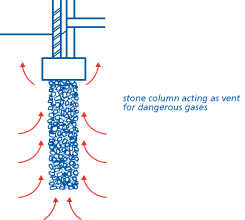
- clays with a plasticity index greater than 40%
- highly sensitive soils liable to collapse or remoulding
Factors to be considered include the following:
- where partial depth treatment of filled ground is proposed, the Engineer should be satisfied as to the anticipated performance of both the treated and untreated zones. The Specialist Contractor should take responsibility for the treated zone and the decision as to the depth of treatment
- the minimum depth of soil treated should allow for the interaction of adjacent foundations
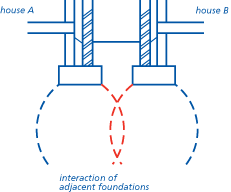
- stone columns may form vertical drains allowing the passage of water to a moisture susceptible strata, or provide seepage paths for gases
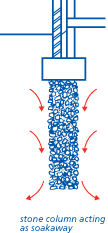
- obstructions and variations in the density of fill and natural ground (hard spots)
- alterations to the oversite level before or after treatment or disturbance of ground by excavations after treatment
- the location of changes in the profile of the natural underlying ground eg edges of pits or quarries, slopes, or manmade obstructions such as soakaways or drainage runs
- long term lowering of water table causing settlement of existing adjacent buildings
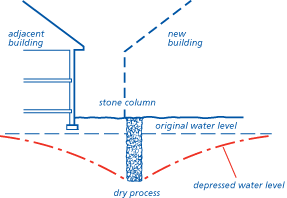
- short term rise in local water table due to large volumes of water used in wet process during construction causing settlement or heave of existing adjacent buildings
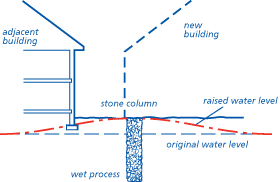
- surface water sewers should be used for rainwater disposal where possible, but where soakaways are necessary, these should be positioned so that their construction and operation is not detrimental to the treated ground
- the effect of any new or existing sustainable drainage systems (SUDS) should be taken into account when vibro improvement techniques are proposed
- soils with a modified Plasticity Index of 10% or greater should have foundations designed to accommodate volume changes, and the depth of concrete foundation should be in accordance with Chapter 4.2 'Building near trees'.
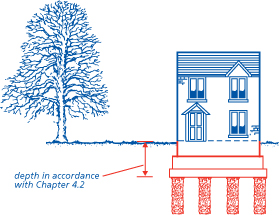
CONFIRMATION OF SUITABILITY OF PROPOSED TREATMENT
Confirmation that the site is suitable for the proposed system should be made available to NHBC prior to commencement of the work.
The Engineer and Specialist Contractor should agree the following in writing before work commences on site:
-
design objectives
- a detailed schedule of work
- a programme of work
- what tests are to be carried out on completion of the work
- responsibility for procedures and tests.
For details of tests see Sitework clause S3.
The following should also be taken into account:
- the layout and depth of the stone columns and the accuracy to be achieved (see Sitework clause S2)
- what factors of safety have been incorporated into the design to allow for unforeseen contingencies
- the criteria for non acceptance of the vibrating poker work
- what calculations and case histories are required to justify the ground improvement proposals together with the layout of the stone columns and details of the equipment and process to be used on site.
These written agreements should be made available to NHBC before work commences on site.
COMPATIBILITY OF LAYOUT AND DESIGN FOR THE TREATED GROUND
Items to be taken into account include:
The Engineer should:
- undertake discussion with the Specialist Contractor to confirm the feasibility of proposals
- determine the loads to be imposed by the buildings and assess against the results of the site investigation
- confirm the required load/settlement performance of the treated ground
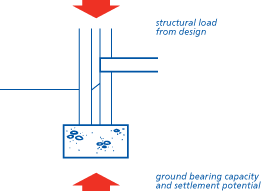
- consider limitations of the configuration of the dwellings:
- T-block and L-block vulnerable at junctions
- vulnerability of long blocks
- avoid siting buildings in locations where major changes in ground conditions can be expected
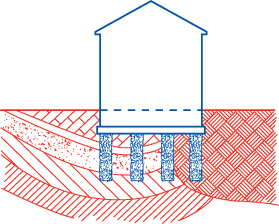
- advise and discuss design criteria with NHBC at the design stage.
The Engineer should:
- establish the likely limits of ground movement
- allow for ground movement in the design, including where appropriate:
- position and spacing of movement joints
- flexibility of masonry mortars
- masonry reinforcement.
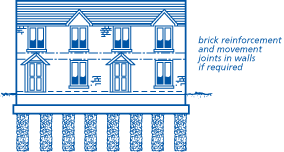
The Engineer should consider the influence of drainage and other service trenches on the stability of the complete design (see Sitework clause S4).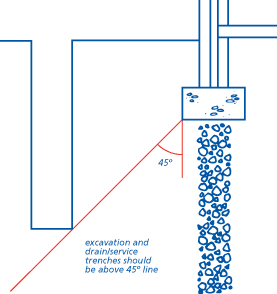
The following criteria should be incorporated in the foundation design to ensure the compatibility and overall stability of the foundations and superstructure:
- only two types of foundations are suitable, both of which should comply with the minimum criteria for areas of reinforcement as defined in BS EN 1992. They are:
- reinforced concrete strip foundation
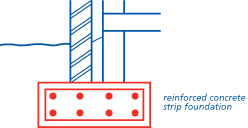
- reinforced concrete raft or semi-raft foundation positioned on a uniformly compacted bed of hardcore

- reinforced concrete strip foundation
- for both types of foundation, top and bottom reinforcement should be provided
- the depth of foundations to be a minimum of 600mm below the surface of the treated ground, and founded on firm material of adequate bearing capacity
- where the treated ground is of a granular nature, a reinforced concrete strip foundation will normally be acceptable provided that the full depth of all fill material is treated
- if the treated ground is of a cohesive nature, a suitably designed raft, semi-raft or reinforced concrete strip foundation will normally be acceptable
- the reinforced concrete foundation should be designed to span between the centres of adjacent stone columns unless a more rigorous structural analysis is carried out to show that an alternative detail is acceptable
- if partial depth treatment of filled ground is proposed then a suitably designed reinforced concrete raft or semi-raft foundation should be used
- if during excavations for foundations in treated ground it is found that excessive depths of concrete are required, then precautions should be taken to ensure overall stability of the foundations, and the Engineer should be satisfied that construction of the foundation will not be detrimental to the treated ground.
Suspended ground floors should be provided for all dwellings where vibratory ground improvement has been carried out unless the Engineer can substantiate an alternative solution that is acceptable to NHBC.
Notice of the proposed development should be forwarded to NHBC.
Inform NHBC of the appointment of the Specialist Contractor and of the anticipated commencement date for treatment.





















